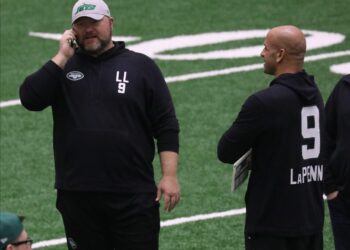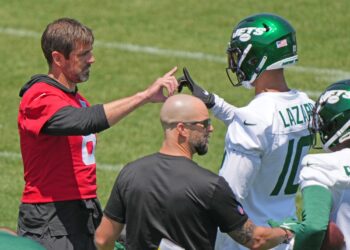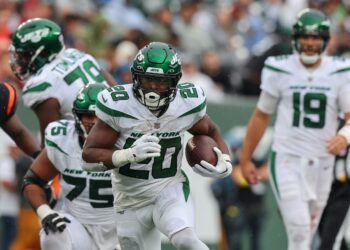The "Real" Heidi Game
The versions are infinite, the exaggerations endless. Most, more colorful then accurate, but all seemingly designed with the intent of serving as the shining example of New York Jet futility. Fact, to the younger generation, has been replaced with myth. And the truth becomes less conspicuous with each passing time the tale is told.
A game that should have been remembered by history as a prelude to the eventual championship attained six weeks later, improperly categorized by the hands of time in what has become an almost forty year game of telephone. Telephone, we all remember the game. A lesson taught to children in order to demonstrate how rumors compound and evolve. A message, whispered from one child’s ear to the next, moving down the line until ultimately delivered to the last recipient, always misconstrued and usually devoid of truth.
A few weeks ago I stumbled upon an article mentioning the game that, for two generations, has grown to epitomize the hopelessness of being a Jet fan. When it dawned on me, for all the times I have heard The Heidi Game referenced, I really didn’t know much about it, or how the events actually played out. I decided to do a little research and find out what really happened that day in Oakland, some forty years ago.
Initially, I expected to find a tale in-line with what I have come to expect from Jet history. Yet another saga commencing with optimism and concluding with despondence. A game whose conclusion makes even the most imaginative of losses seem tame and whose outcome foreshadowed a teams fate for the next four decades. What I found was something entirely different all together.
I expected to read about a monumental lead, lost in a matter of seconds. A margin seemingly so safe that NBC saw no hazard in skipping to its finale, already classifying it a foregone conclusion. What I found was just one chapter of a rivalry whose intensity and brutality would come to define both teams in the late sixties and a decision made by a television network that does more to illuminate the enormous strides the game of football has taken then it does in demonstrating a team’s ineptitude.
PROLOGUE
Sonny Werblin drafted Joe Namath in 1965 as much for his star-power as his quarterbacking abilities. Being a showbiz man himself, once the vice-president of MCA, Werblin saw his new signal caller as the symbol of what he hoped the AFL would come to encompass. A sport, since its inception, dominated by the straight-coat, top-buttoned, NFL types. Ideals epitomized by the cross-town rival New York Giants and their owner, Wellington Mara. Namath, he hoped, would come to represent the anti-establishment. He would be the Jets main attraction and the AFL’s answer to the crew-cut quite demeanor of Johnny U and the rest of the archaic institution that Werblin saw as the NFL. The shaggy-haired gunslinger, whose abilities on the field and antics off would ultimately propel the AFL into contention and eventually force a merger.
By the start of the 1968 season the Jets were already a team with championship aspirations. A year earlier, in his third season as a pro, Namath had led the team to a respectable record of 8-5-1. Since the arrival of Broadway Joe, the Jets had steadily progressed. And now, in an opinion shared by their ever growing fan-base and perpetuated by their brash young quarterback, they felt poised to make a run at a championship.
And, why shouldn’t they have felt confident? After all, Namath was entering his prime. He had a tremendous asset in wide-receiver Don Maynard and his ability to haul in the long ball. The backfield of Snell and Boozer was fast and strong and overshadowed by the explosive offense was a defense that by many accounts was among the AFL’s best in ‘68. The Jets felt they could beat anybody, a prophecy they would ultimately fulfill.
However, optimism and legitimacy were sentiments not shared by the rest of the football community. Secluded was it from the rest of the football world who, in large measure, still saw in the AFL an inferior product. And in Joe Namath, a loud mouthed kid who was more a detriment to the countries values then the testament to confidence he would one-day become.
Sharing in those feelings were the Oakland Raiders. While Joe was confident in his team, The Raiders, being as they were the defending AFL champs, had other ideas. Spearheaded were they by a viscous defensive front, who since 1965, had learned to derive great pleasure from the site of the $400,000 dollar quarterback on his back. Led by Ike Lassiter and Ben Davidson, they were a mean group who looked to punish their opponents.
In the four years since Namath had been under center, the Jet-Raider rivalry had picked up steam and by this point had developed into all-out warfare. Be it as it may, the Raiders had proved to be the dominant of the two. In the teams six meeting prior to the 68’ season, New York had managed only a single win. Despite equivalent records of 7-2, odds-makers favored the defending champs by 7 ½ points.
HEIDI MAKES HER APPEARENCE
By the fourth quarter, the game had developed into a shootout. While Namath was finding Maynard for 228 yards in the air, Oakland’s Daryle Lamonica was finding similar success with his counterpart in Fred Biletnikoff. The crowd, both in attendance and watching at home, was beginning to think that whoever had the ball last would win. Namath changed their minds by leading an efficient fourth quarter charge, transforming a three point deficit into a three point advantage in the span of eight minutes. With 1:05 left to play, the Jets once again, handed the ball over to the Raider offense.
Here’s where things get interesting.
Despite what forty years worth of history has mangled of the story; by all accounts there was no monumental collapse. Contrarily, this was a flimsy three point lead in a game that proved to be lacking in anything but offense. By today’s standards, a minute of game time coupled with a margin as miniature as a field goal, would by no means be considered safe.
Following the kickoff, NBC, contractually obligated to Timex, a sponsor they obviously valued with a higher worth than the AFL, broke too commercial and returned not with the start of the Raider drive, but rather with the start of the Disney movie Heidi, the tale of a pig-tailed orphan, who would forever be remembered not for it’s content but rather for its inevitable place in football history.
Those in attendance went on to witness Daryle Lamonica pierce through the overly aggressive Jet secondary and connect with Charles Smith for the go-ahead touchdown. With only seconds left on the clock, the Jets special teams unit, already in full-fledged desperation mode, fumbled the ensuing kickoff and saw it returned for a touchdown.
Fourteen points in nine seconds. None of them seen by fans East of Denver.
Lost in the history of a game that has come to emblematize the failures of an organization is the very nature of the era in which it was played.
Today, we view a three point margin and a minute on the clock, as a field goal and a chance for overtime. In 1968, with the advent of overtime still years away, teams routinely played to a tie. In a game of such magnitude, most coaches were inclined to trust their quarterback long before their kicker. This is exactly what Raider coach John Rauch did, he trusted his quarterback. In Lamonica, Rauch has one of the best in the league. And when it mattered, Lamonica delivered.
In the years since NBC opted to honor their obligation to Timex, much has been made about what actually occurred behind the scenes at NBC that afternoon. Widely reported are those stories of network executives panicking in anticipation of catastrophe, unable to get hold of their operators in their last ditch efforts to avert disaster. Stories of blown switchboards, busy signals, and cursing fans all wanting to know what had happened. All true, yet undeniably overblown with time.
THE ‘X’ FACTOR
The fact is, despite the NFL’s incessant pursuit of proving otherwise, betting is a part of the game. Wagers and money affected fans then just as they continue to do so now. As generations pass and the legend of the Heidi game continues to grow, so to does its intrigue and amplification. History wants us to believe that the games conclusion was a foregone conclusion, a margin so vast that its inevitable outcome could never be duplicated again. I’m here to tell you, history is wrong. Or, at the very least, it has opted to omit one significant detail.
For all intensive purposes the game ended with the touchdown to Smith. The fumbled kickoff did little to affect the outcome other then to stretch the final margin of victory from four points to eleven. This seemingly inconsequential play, of course, only seemed meaningless to people who hadn’t wagered on the game. As Mark Kriegel points out in his recount of the game, “the first touchdown cost Jet fans the game, the second cost them their bets.�
Taking the point a step further, wouldn’t it makes sense that an NBC switchboard operator would make for an extremely accessible target for any fan feeling those inherently embittered emotions usually accompanying the frustration associated with financial loss? Failure to, at the very least, mention the legion of slighted fans, a group forced to learn of their fiscal loss via a crawling message on their television set forty-five minutes after the fact, is in my mind tantamount to prevarication.
WHAT THE 1968 SEASON SHOULD BE REMEMBERED FOR
In 1968, the AFL was in its infancy. Despite the best efforts of Werblin and his skirt chasing quarterback, their league was still considered a substandard product in comparison to the NFL. Aside from Namath’s contract, the real money was in the NFL and that’s where the players, coaches, writers and everyone in between wanted to be. NBC, nor the rest of the country, was yet to accept the AFL with same sense of seriousness that they had the NFL. It was the outcry following NBC’s flub that helped change that.
What history should illuminate is not the Jets kickoff blunder, but rather the game itself. From a television standpoint, the significance of the blunder was colossal. Never again would a broadcasting network have the right to deprive fans of their right to see a game in its entirety. Meanwhile, the resulting fallout from herds of angry fans put television and NFL executives on notice, the AFL and their loud-mouthed quarterback weren’t going away. NBC learned they had a product that would sell and the NFL learned they had a predicament they could no longer ignore.
There, perfectly illuminated by the thousands of irate callers, was a shining example of the AFL’ inception and a stepping-stone for the eventual merger that was now imminent.
As the story continues to be passed from one generation to the next, likely, it will continue to be remembered as the first in a long line of Jet meltdowns. A lead so safe that a television network saw little consequence in abandoning its conclusion and in making the assumption that the outcome was all but solidified.
I argue otherwise. The game, to Jet fans, should not be considered a blunder, but rather a martyr. For their role in the game, the Jets should be seen as the unfortunate byproduct of serving on the losing end of game whose consequences help pave the way for the games evolution.
More importantly, as Jet fans, its time we add our own caveat to the story.
The next time you decide to give your version, don’t forget to throw in that one last nugget of truth; that one last point that history has so conveniently omitted from the tale. Six weeks later, Joe and his gang would go on to avenge the loss at home, beating the Raiders 27-23 in the AFL championship. And in doing so, set the stage for the most famous guarantee in sport history and the greatest game this organization has played.
Videos
News and Notes from First Two Days of Jets Training Camp










